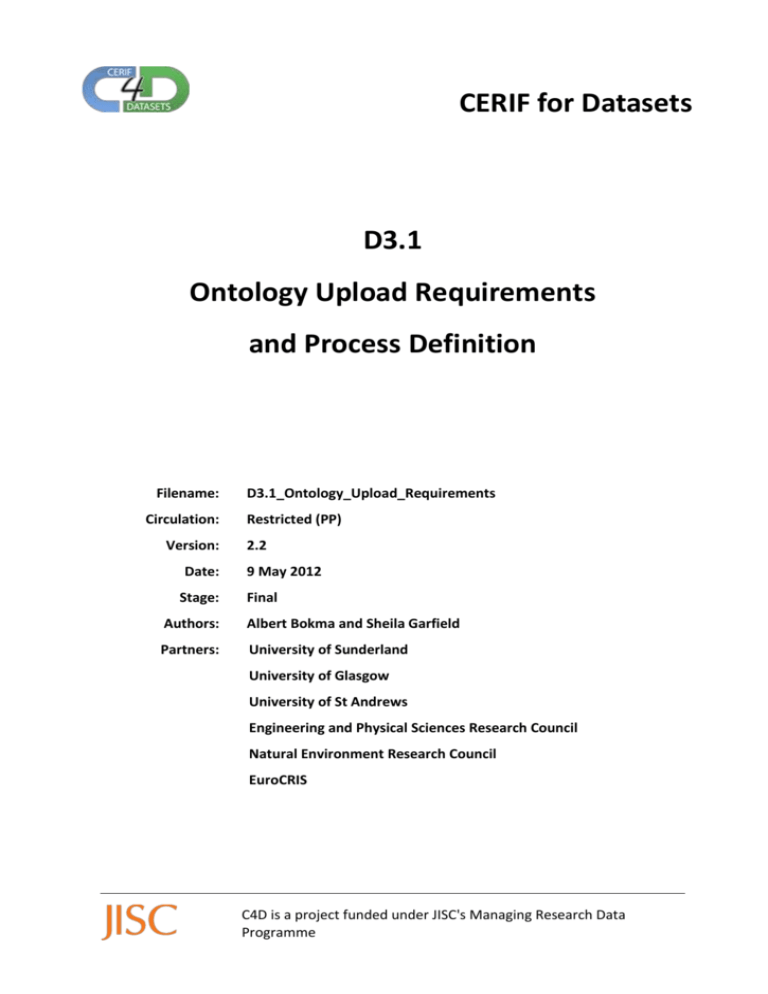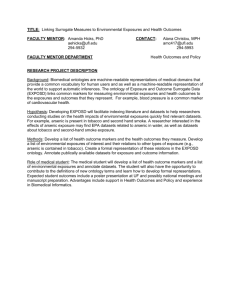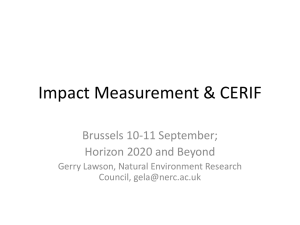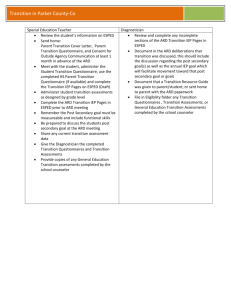
CERIF for Datasets
D3.1
Ontology Upload Requirements
and Process Definition
Filename:
Circulation:
Version:
Date:
Stage:
D3.1_Ontology_Upload_Requirements
Restricted (PP)
2.2
9 May 2012
Final
Authors:
Albert Bokma and Sheila Garfield
Partners:
University of Sunderland
University of Glasgow
University of St Andrews
Engineering and Physical Sciences Research Council
Natural Environment Research Council
EuroCRIS
C4D is a project funded under JISC's Managing Research Data
Programme
C4D
D3.1 Ontology Upload Requirements
COPYRIGHT
© Copyright 2011 The C4D Consortium.
All rights reserved.
This document may not be copied, reproduced, or modified in whole or in part for any purpose without written
permission from the C4D Consortium. In addition to such written permission to copy, reproduce, or modify this
document in whole or in part, an acknowledgement of the authors of the document and all applicable portions
of the copyright notice must be clearly referenced.
This document may change without notice.
DOCUMENT HISTORY
Version Issue Date
Stage
Content and changes
V1.0
4 May 2012
Draft
Draft
V2.0
9 May 2012
Draft
Comments and changes incorporated
V2.1
10 May 2012
Late
V2.2
10 May 2012
Final
Version 2.2 of 10 May 2012
D3.1 Ontology Upload Requirements.doc
Page 2/12
C4D
1
D3.1 Ontology Upload Requirements
INTRODUCTION
The goal of the CERIF for Datasets (C4D) project is to extend CERIF to effectively deal with research
datasets. Datasets for the purposes of this paper are collections of data which are usually structured
and in tabular form where each row represents a record with a number of fields that hold data on
various attributes and that have been generated in the course of research activity, whether they
record experimental results or original observations.
CERIF in its core entities has a current focus to record information about people, projects,
organisations, publications, patents, products, projects, facilities, and equipment. One aspect which
is not specifically covered, though becoming of increasing interest is research datasets as a form of
research output. In some disciplines there are considerable amounts of datasets generated which
are an important output; these may be of use also to other researchers as a useful input to their
research and potentially to help improve research and speed up the rate of discovery and be in itself
a useful indicator of impact. Transparency and access is increasingly a feature of the public sector
and making results more readily available and discoverable are now the order of the day; especially
when these were generated with the assistance of public funds there is also a moral obligation to
make results available for inspection and reuse. In addition to the moral argument there is also
increasing legislation in this direction that places specific requirements on researchers and their host
organisations.
These data collections, beside the activity out of which they arose, can be very useful for future
research also by other researchers; they present a formidable resource if properly managed. With
the appropriate safeguards in place for the protection of the results and proper acknowledgement
and, if necessary, licensing, they have the potential for propelling research. However, due to lack of
concrete knowledge as to who holds which datasets in the relevant research community this means
that their potential remains currently underutilized.
Dataset A
Metadata
Dataset B
Metadata
Dataset n
Metadata
C4D enhanced
CERIF
Repository
JISC Advance/SSPS HE
Cloud & ESB
C4D Navigator
Publications
Institutions
Datasets
Projects
Researchers
Figure 1: C4D Ontology based navigation/retrieval
Version 2.2 of 10 May 2012
D3.1 Ontology Upload Requirements.doc
Page 3/12
C4D
D3.1 Ontology Upload Requirements
The access to these would be useful for researchers and would have additional benefits for the
sharing parties by demonstrating the impact they create. Consequently, there is a need for recording
these with easy to use tools and publishing them in a way that facilitates their discovery. To enable
these benefits to be realised poses some specific problems:
The generation of metadata is not always easy and intuitive and can become onerous once
lots of datasets are generated on a regular basis and tools are needed to make sure that
correct and appropriate metadata can be generated by researchers or support staff. This may
sound easy but experience has shown that a considerable amount of checking and data
cleaning can be required to achieve this in practice.
In a distributed and networked world where there is increasing mobility of data and data
holders there is a need for standards so that data can be extracted, migrated, integrated or
aggregated successfully without requiring significant human intervention.
As discovery is an important issue to make these resources findable and useful. This also
requires the use of appropriate classification systems alongside. Relevant datasets may exist in
a variety of repositories and may have arisen in other disciplines. A poignant example is the
work of the Sea Mammal Research Unite (SMRU) where in the course of biological research
records are created that are of specific interest for climatological research and thus crossdisciplinary cases are not uncommon.
In Figure 1, above, the conceptual framework for C4D is presented that shows where C4D fits into
the current research landscape and what it attempts to provide in practical terms. Given the
motivations stated earlier C4D attempts to find a solution to this problem and consequently focuses
on the following issues:
Examining the support and extension requirements of CERIF to support datasets
Proposing a flexible standard for the metadata for datasets based on existing ones to cover a
variety of disciplines
Choosing an appropriate classification system to facilitate storage and retrieval of datasets or
the metadata about datasets
Developing tools for the manual generation of metadata into a CERIF compliant metadata
data store and their exchange with other CERIF compliant data stores
Discovery and retrieval as well as exploration in relation to other key entities associated with
these datasets such as owners, publications, organisations and projects.
In the following we look at the classification scheme to be employed before considering the
proposed system architecture and ontology support requirements.
2
CLASSIFICATION TAXONOMY REQUIREMENTS
The ROS categories provide a comprehensive, hierarchical, set of elements for inputting information
with regard to outcomes from research. Within each of the top level outcome types (categories)
there are additional selection criteria or options available at a first tier and a second tier level. For
example, the top level “Other Research Outputs” outcome type has options, at the first tier, for
biological outputs, electronic outputs and physical outputs; for electronic outputs, at the second tier
level, there is the option of selecting ‘dataset’ which is described as “a structured record of the value
of variables that were measured as part of the research”.
The RCUK classification scheme has 78 first level categories and then subcategories to level 3. The
main categories and selective subcategories are shown in the list below. Please note that resolution
at level 3 can vary from a single subcategory to 30 or more:
Version 2.2 of 10 May 2012
D3.1 Ontology Upload Requirements.doc
Page 4/12
C4D
D3.1 Ontology Upload Requirements
Agri-environmental science
o Agricultural systems
o Crop protection
o Crop science
o Earth and environmental
o Soil science
Animal science
o 3Rs [Reduction, Refinement, Replacement]
o Animal and human physiology
o Animal behaviour
o Animal diseases
o Animal organisms
o Animal reproduction
o Animal welfare
o Endocrinology
o Immunology
o Livestock production
o Musculoskeletal system
o Parasitology
o Psychology
o Systems neuroscience
Archaeology
o Archaeological Theory
o Archaeology Of Human Origins
o Archaeology Of Literate Societies
o Industrial Archaeology
o Landscape & Environmental Archaeology
o Maritime Archaeology
o Palaeobiology
o Prehistoric Archaeology
o Quaternary Science
o Science-Based Archaeology
Astronomy - observation
o Astronomy & Space Science Technologies
o Data Handling & Storage
o Extra-Galactic Astronomy & Cosmology
o Galactic & Interstellar Astronomy
o Instrumentation for Particle Physics Or Astronomy
o Stellar Astronomy
Astronomy - theory
o Computational Methods and Tools
o Extra-Galactic Astronomy & Cosmology
o Galactic & Interstellar Astronomy
o Stellar Astronomy
Atmospheric physics and chemistry
o Atmospheric Kinetics
o Boundary Layer Meteorology
o Land - Atmosphere Interactions
o Large Scale Dynamics/Transport
o Ocean - Atmosphere Interactions
o Radiative Processes & Effects
o Stratospheric Processes
o Tropospheric Processes
o Upper Atmosphere Processes & Geospace
o Water In The Atmosphere
Atomic and molecular physics
o Atoms and Ions
o Cold Atomic Species
o Fusion
o Light-Matter Interactions
o Scattering & Spectroscopy
Bioengineering
Version 2.2 of 10 May 2012
D3.1 Ontology Upload Requirements.doc
Page 5/12
C4D
D3.1 Ontology Upload Requirements
o
o
o
o
o
o
o
o
o
o
o
Biochemical engineering
Bioenergy
Biomaterials
Bionanoscience
Bioreactors
Environmental biotechnology
Macro-molecular delivery
Metabolic engineering
Novel industrial products
Protein engineering
Tissue engineering
Biomolecules and biochemistry
o Ageing: chemistry/biochemistry
o Biochemistry and physiology
o Bioenergetics
o Biological membranes
o Biophysics
o Carbohydrate Chemistry
o Catalysis and enzymology
o Chemical Biology
o Multiprotein complexes
o Protein chemistry
o Protein expression
o Protein folding / misfolding
o Structural biology
Catalysis and surfaces
o Catalysis and Applied Catalysis
o Complex fluids and soft solids
o Electrochemical Science and Engineering
o Surfaces and Interfaces
Cell biology
o Ageing: chemistry/biochemistry
o Cell cycle
o Cells
Adipocytes
B cells
Basophils
Blastocyst
Cells
Chondrocyte
Collenchyma
Dendritic cells
Endothelial cells
Eosinophils
Epidermal cells
Epithelial cells
Erythrocytes
Granulocytes
Guard cells
Haematopoietic stem cells
Hepatocytes
Keratinocytes
Leukocytes
Lymphocytes
Macrophages
Mast cells
Melanocytes
Myocytes
Natural killer cells
Neutrophils
Oocytes
Osteoblasts
Version 2.2 of 10 May 2012
D3.1 Ontology Upload Requirements.doc
Page 6/12
C4D
D3.1 Ontology Upload Requirements
Osteoclasts
Osteocytes
Pancreatic alpha cells
Pancreatic beta cell
Parenchyma
Photoreceptor cells
Platelets
Regulatory T cells
Sclerenchyma
Stem cells
Stromal cells
T Cells
Trophoblast
o Communication and signalling
o Organelles and components
o Receptors
o Stem cell biology
Chemical reaction dynamics and mechanisms
Chemical measurement
Chemical synthesis
Civil engineering and built environment
Classics
Climate and climate change
Complexity science
Cultural and museum studies
Dance
Demography and human geography
Design
Development studies
Drama and theatre studies
Ecology, biodiversity and systematics
Economics
Education
Electrical engineering
Energy
Environmental engineering
Environmental planning
Facility Development
Food science and nutrition
Genetics and development
Geosciences
History
Information and communication technologies
Instrumentation, sensors and detectors
Languages and Literature
Law and legal studies
Library and information studies
Linguistics
Management and business studies
Manufacturing
Marine environments
Materials processing
Materials sciences
Mathematical sciences
Mechanical engineering
Media
Medical and health interface
Version 2.2 of 10 May 2012
D3.1 Ontology Upload Requirements.doc
Page 7/12
C4D
D3.1 Ontology Upload Requirements
Microbial sciences
Music
Nuclear physics
Omic sciences and technologies
Optics, photonics and lasers
Particle astrophysics
Particle physics - experiment
Particle physics - theory
Philosophy
Planetary science
Plant and crop science
Plasma physics
Political science and international studies
Pollution, waste and resources
Process engineering
Psychology
Social anthropology
Social policy
Social work
Sociology
Solar and terrestrial physics
Superconductivity, magnetism and quantum fluids
Systems engineering
Terrestrial and freshwater environments
Theology, divinity and religion
Tools, technologies and methods
Visual arts
Table 1: The RCUK Subject Classification Scheme
Overall, the RCUK categories present a good level of detail with regard to research outputs and could
provide the fine detail that will be needed for the C4D subject demonstrator.
Given the aim of C4D to manage metadata of datasets for a variety of disciplines and in particular to
support the discovery of them in terms of search based retrieval or explorative browsing the RCUK
categories set seems to be a better fit also with a view to generating a scalable solution.
Furthermore, the fact that RCUK is already in wider circulation in research councils for use with grant
applications and research outputs this would also provide a compatible solution that would allow
potentially data from different locations and different types to be integrated at the point of
browsing.
The ontology will need to cover in the core concepts the key entities in the CERIF data store
especially where these are related to datasets but will for classification purposes include a complete
classification system in taxonomic form.
Version 2.2 of 10 May 2012
D3.1 Ontology Upload Requirements.doc
Page 8/12
C4D
D3.1 Ontology Upload Requirements
3
PROPOSED C4D DISCOVERY ARCHITECTURE
Once datasets are fully supported in CERIF, and CERIF data stores, whether distributed or
centralised, these data stores will be a formidable information resource that will serve a variety of
users and uses. To be able to fully unlock this potential a number of issues have to be addressed:
generation of correct metadata and integration with existing records where necessary
(potentially also completing missing information in related records)
facilitating the discovery of relevant records through appropriate retrieval mechanisms
(even across distributed repositories)
enabling the browsing and navigation of relevant datasets and their associated people,
organisations, projects and publications
The generation of correct metadata and the correct insertion of records in a CERIF repository will
require linking it correctly to already existing information such as that about people, organisations
and projects or alternatively initiate the creation of additional records (e.g. a dataset needs a person
who generated and owns it and should be linked to a project through which is was created and an
organisation who hosted the project etc.). This will draw on some earlier work of the authors such as
(Bokma 2004) and (Tektonidis & Bokma 2006).
Alternatively, it might also require links to be made to data in other repositories in a distributed
environment where data is to be subsequently searched and retrieved. Finally, the navigation of
datasets and related entities will require connections to be made that might not be explicitly present
in the existing record. For this reason it is necessary to have a mechanism that can look at
relationships and expectations with respect to correct records and be able to reason about it, be it
for the purpose of the generation of correct records, data cleaning or browsing.
C4D will develop an ontology, and an ontology-driven interface to CERIF data stores which will
provide the key features of import, discovery, exploration and linking.
By modelling the key concepts of people, projects, publications, organisations and results an
interface can be built that has the desired functionality of enabling the non-invasive retrieval of
records also across data stores and the representation and navigation of links between entities so as
to, for example, visualise related records surrounding a particular dataset, such as other datasets,
researchers, publications, projects, etc. This will enable the vision presented in Figure 1 above to
provide for powerful retrieval and navigation of these intrinsically related entities. For the thematic
retrieval of datasets and as a starting point for showing related entities the use of a classification
system will also be important and hence the integration of the RCUK classification system into an
eventual ontology as discussed in section 2. When dealing with distributed repositories and where
there may be inconsistencies and there is not the possibility to enforce data-cleaning it is important
to have a flexible mechanism that can resolve these in a non-invasive way at the point of combining
and aggregating retrieval results.
In order to make use of existing work to develop a comprehensive solution, one possible approach
could be to base the application on R2O and ODEMapster – see (Buil-Aranda, Corcho et al 2009).
R2O & ODEMapster is an integrated framework for the formal specification, evaluation, verification
and exploitation of the semantic mappings between ontologies and relational databases. This
integrated framework consists of:
R2O, a declarative, XML-based language that allows the description of arbitrarily complex
mapping expressions between ontology elements (concepts, attributes and relations) and
relational elements (relations and attributes)
ODEMapster processor, which generates Semantic Web instances from relational instances
based on the mapping description expressed in an R2O document.
Version 2.2 of 10 May 2012
D3.1 Ontology Upload Requirements.doc
Page 9/12
C4D
D3.1 Ontology Upload Requirements
Figure 2 below shows how such a system architecture would work by linking to an existing metadata
repository (CERIF) which holds the records on researchers, projects, publications and datasets; this
would be accessed using ODEMapster. The application then uses the C4D ontology and maps it to
the database using R2O mappings and then allows the database to be searched and data to be
retrieved by interrogating the domain ontology. Depending on user preference this can then be
accessed through a traditional tabular search facility or through an interactive graphical
representation that allows the collection of information to be navigated and browsed. Also, the
benefit of this approach is that it could be easily extended to deal with a variety of repositories and
allow the data to be combined for more unified and transparent navigation. However this would
require additional effort to deal with merging of data from different sources.
C4D - CERIF
Domain
Ontology
Protégé
C4D Navigator
(Import, Search and Visualisation)
R2O
Mappings
RDB
Ontology
ODEMapster
CERIF Repository
Figure 2: Application of Metadata Ontology
The use of a common classification scheme in combination with these key concepts will allow any of
these categories and existing records to be managed for the purpose of discovery and integration.
Thus the ontology will also need to contain the classification scheme as a topic hierarchy to be used
to classify individual researchers, projects, datasets and publications so that the activities in
particular subject areas become extractable and so that the proposed vision of being able to explore
activity surrounding particular datasets, as depicted in the graphical form reproduced above, is
achieved. The fact that the RCUK classification scheme is also hierarchical is useful as it allows a
richer set of functionality to be generated rather than out of a flat dictionary.
In the following we explore the key concepts of the ontology and their relationships. The proposed
implementation will follow the architecture described in Figure 2 above and comprise:
Dataset: with references to the entity owning it (person or orgunit) and that is stored in a
repository; datasets also to have one or more (ROS) classifications
Project: with reference to relevant fundholder, orgunit and generating datasets
Person: with ownership of datasets and authorship of publications
Publications: with authorship of person, references to datasets and affiliation of authors to
orgunits
Version 2.2 of 10 May 2012
D3.1 Ontology Upload Requirements.doc
Page 10/12
C4D
D3.1 Ontology Upload Requirements
Orgunits: referring to persons as staff members and hosting projects and curating datasets
Repositories: containing actual datasets and referring to owners and data management plan
isHostedBy
Project
Orgunit
isGenerating
Repository
hasStaff
isStoredIn
Dataset
isOwnedBy
Person
hasClassification
isReferringTo
Classification
isAuthorOf
Publication
Figure 3: C4D Ontology Core Concepts
The ontology will contain as a main core concept Classification where ROS will be represented in
taxonomic form to be used as a classification as one object property of Dataset.
Figure 3 above shows the core concepts and their principal relations. By adding appropriate
restrictions it will also be possible to reason about datasets and their relationships to other entities
and uncover new links or infer or alert to missing information which are crucial to a consistent
dataset. The ontology will be mapped to the CERIF data store to point at the relevant CERIF entities
and related properties and entity relations.
By linking the ontology to the CERIF data store, the relevant records can be retrieved for retrieval
and navigation purposes as well as managing the correct generation and insertion of new records to
be discussed in Deliverable D3.2. The proposed architecture of separating the ontology and
application from the CERIF data store itself also allows the approach to be used with few
modifications in a distributed environment where records are located in separate CERIF data stores.
Version 2.2 of 10 May 2012
D3.1 Ontology Upload Requirements.doc
Page 11/12
C4D
D3.1 Ontology Upload Requirements
References
Bokma A., Solomon N., Harvey H. & Jones S., “NOPIK: Creating Shared Conceptualisations for Information and Knowledge
Sharing in the Virtual Enterprise”, Proc. of the 10th International Conference on Concurrent Enterprising - ICE2004,
Seville, June 14-16, 2004
Carlos Buil-Aranda, Oscar Corcho and Amy Krause, “Robust service-based semantic querying to distributed heterogeneous
databases” (2009) 20th International Workshop on Database and Expert Systems Application, Linz, Austria, August 31September 04, ISBN: 978-0-7695-3763-4
Dimitrios Tektonidis & Albert Bokma, “Adapting ontologies for integrating e-Government Information Systems”, 2nd
International Conference on Interoperability of eGovernment Services, 22-24 March 2006, Bordeaux, France, ISSN:
1773-0279
European Commission (2008) INSPIRE Metadata Regulation 03.13.2008. Available from:
lex.europa.eu/LexUriServ/LexUriServ.do?uri=CELEX:32008R1205:EN:NOT [Acc. 6 December 2011]
Version 2.2 of 10 May 2012
D3.1 Ontology Upload Requirements.doc
http://eur-
Page 12/12









